 Student
Learning in Physical Education-2nd Edition
- Applying Research to Enhance Instruction Student
Learning in Physical Education-2nd Edition
- Applying Research to Enhance Instruction
Publishers:
ISBN-10:
073604275X
ISBN-13:
9780736042758
Description:
360pp, Hardback, Copyright 2003
Authors:
Stephen J. Silverman,
Catherine D. Ennis
Reviewer: Ted Scheck
In 1972 a report came out by W. Marland
on the status of gifted education in the
United States. Interestingly, the psychomotor
component from which advanced study in
physical education occurs was included.
I was 9 years old at the time, so even
if someone had explained that all the
jumping around on the trampoline and kickball
and 600-yard dashes we ran had something
to do with the original report, I doubtfully
would have cared. My Dad and Uncle were
PE teachers, and I knew, at a young age,
that it was the filed I was destined to
work in.
Interestingly (and sadly, in my opinion)
the psychomotor component was later removed.
Children in Art can be gifted and receive
services that, hopefully, will meet, match,
enhance, and develop their gifts and talents.
Music is very similar, but Physical Education?
Why is the field of movement so important
to some, but not important enough to warrant
specialized services to develop it?
One would argue that ‘Varsity
Athletics’ is, of itself, a program
for psychomotor giftedness, but I would
not agree. I am in my second class out
of a 4-class certification in Gifted Education
at Ball State University, and I’m
finding many similarities in the book
I’ve reviewed and my own coursework.
I appreciate how the editors, Silverman
and Ennis, treat the field of Physical
Education. Powerful metaphoric imagery
is used on the very first page, comparing
the field of physical education pedagogy
as having gone from childhood, to adolescence,
and finally, to adulthood. It’s
a great analogy, and sets a tone for the
rest of the book. And it is true: the
amount of research in the field of physical
education has, over the years, progressed
on a level that demands that other practitioners
take a closer look. P.E. is not just about
kickball and dodgeball, as the media likes
to paint and portray, and P.E. teachers
are not all mindless military-minded buzz-cut
brutes whose task is only to shame, torment,
torture, and humiliate. I had three gym
teachers who had a tremendous effect on
my life: my father, Ed Scheck, from the
old school, Mr. Ballanger, the greatest
non-relative gym teacher I ever had, and
his successor, a man I shall not name,
who engaged in the old school, highly
stereotyped version. The field has grown
up since the 1970s, due to the hard work,
patience, study and critical analysis
of itself due to men and women dedicated
to advancing it.
A Venn Diagram on the next page nicely
sums up the three pillars in physical
education pedagogy: curriculum, teacher
education and teaching itself. This is
very similar to the pillars of gifted
education, causing me to wonder (nearly
constantly) if a new report should be
written, one that reinstates the psychomotor
component into the field of gifted and
talented.
Chapter Two takes us back in time to
the evolution of research in physical
education. The author again uses an incredibly
powerful image of the ‘binoculars
through which we look’ to take a
healthy, critical look at our own ways
of researching what is going on right
in front of our noses, and far away, metaphorically,
in our own field. Now history can be a
bit dry for me, unless I can somehow connect
the past with the ever-changing future.
We are taken back to the research done
in the 1940s, looking to match good teacher
characteristics and highly-effective teachers
with rating scales. In 1964, with physical
education becoming an academic discipline,
a much-needed booster-shot was given to
the behind of the field and the curricular
focus became more intense.
Very deep issues are covered in this
book, a few of them that I will mention
for your own curiosity: gender issues
in physical education, students with disabilities,
standards-based program designs, attitudes,
cognition, and motivation, assessment,
health-related PE and wellness, teaching
sport within PE, and a topic I’ve
always wanted to pursue, and will, with
the help of this book: Interdisciplinary
Curriculum in PE: Possibilities and Problems.
To go into detail of each chapter is
not the goal of this reviewer. I found
the entire text extremely interesting,
with many examples in the bibliography
to further my own curiosity. Research
is key in any field, especially a field
that continues to have such a negative
and stereotyped reputation. Television,
movies, and print media continue still
to poke fun at the field of physical education.
In my own experience within Indianapolis
Public Schools, this perception is, in
part, still accurate. Gym is where ‘kids
run around’ and where children ‘throw
things at each other’ and where
kids, according to some classroom teachers,
‘let off steam’. Only through
our dedicated efforts, both in teaching
and in research, can we lift the field
of Physical Education out of the logy
quicksand of ill-perceived Hollywood minds
and bring it, bright and shiny, to the
place where it belongs. And that will
happen only when P.E. teachers finally
take what Mr. Marland’s reviewers
did not do – elevate Physical Education
to the status, or near the status, of
gifted and talented education.
A thoroughly-researched text, “Student
Learning in Physical Education”
is a must for anyone in or pursuing a
Master’s Degree, any teacher wishing
to deepen their own teaching, and the
curious regarding research in physical
education.
|



